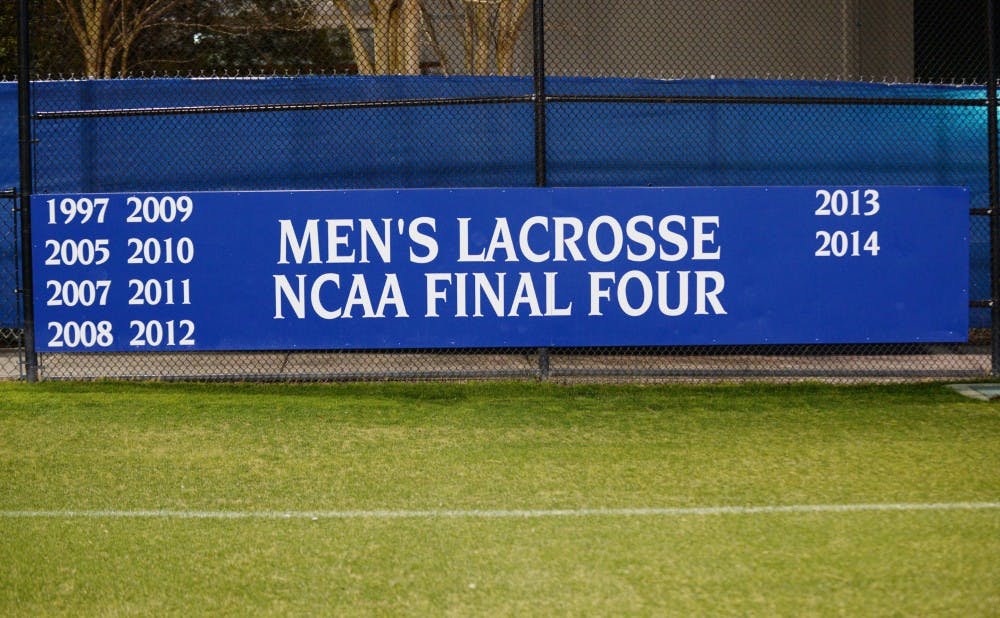This story is part of our coverage of the 10th anniversary of the lacrosse case. Our other coverage can be found here.
When Duke President Richard Brodhead canceled the rest of the lacrosse season on April 5, 2006, amid allegations that members of the team had raped a woman at an off-campus party, the jolt threatened to throw the program's on-field product into disarray when the Blue Devils returned to Koskinen Stadium in 2007.
The team's schedule on Duke's athletics website for that 2006 season lists the eight games the Blue Devils played prior to the announcement, but no mention of any other scheduled games. Duke went 6-2 in those contests and seemed every bit the national title contender that many expected the Blue Devils to be just a year removed from a heartbreaking loss to Johns Hopkins in the national title game.
But then a seemingly damning email written by Duke defenseman Ryan McFadyen was made public in the wake of the allegations surrounding the off-campus party, and everything changed—again. Brodhead moved to cancel the season, head coach Mike Pressler resigned and suddenly the program's future was on shaky ground, both on and off the field.
When Southern Methodist was handed the so-called "death penalty" for repeated NCAA violations in the 1980s, it brought a college football powerhouse to its knees. But in Durham, Duke navigated that pitfall by luring away one of the top coaches in the country from Hofstra.
The situation that John Danowski inherited when he arrived on campus was hardly enviable, but he quickly set about trying to return to the field and get back to competing for championships.
"You get stronger, you learn and improve, or you can go the other way," Danowski said during his introductory press conference July 21, 2006. "But certainly here, it appears to me that everybody's working really hard to learn from past experiences and push forward."
Push forward they have.
Ten years ago, the program was mired in uncertainty as the lacrosse case played itself out. Now, the only near-certainty is that—with the exception of last season's loss to Ohio State—the Blue Devils will be busy on Memorial Day weekend, competing for a national championship.
Under Danowski's guidance, Duke has advanced to eight Final Fours in nine seasons, capturing three of the last six national titles and cementing itself as one of the premier programs in college lacrosse.
In Danowski's first season on the sidelines—which marked the return of the Blue Devils to the field, where they once more had control over wins and losses, rather than fighting a battle against public perception—Duke exactly replicated its last full season under Pressler. The Blue Devils pieced together a 17-3 record and advanced to the national championship game before falling one win shy of a title.
The next year brought the same promise, and the same crushing disappointment. Duke won 18 games—a program-record—but fell 10-9 to Johns Hopkins in the Final Four.
The breakthrough finally came in 2010, just five seconds into overtime. Blue Devil faceoff specialist C.J. Costabile bested his Notre Dame opponent at the draw, then scampered unmarked straight down the middle of the field, slipping a shot past Fighting Irish goalkeeper Scott Rodgers.
That goal—the one that sealed the first NCAA championship in program history—brought with it ripple effects that began to elevate the Blue Devils to the ranks of the elite programs in the country.
"Maybe, maybe, if things go well, your team could compete for a national championship," Danowski said. "But we don’t focus on that, because that’s not a given and we don’t know that as coaches. But maybe we do know that you can play on ESPN six or seven times, and maybe you can play in front of 50,000 people on Memorial Day weekend. And so we think that’s worth it."
Danowski said he does not have a recruiting pitch, instead laying out the expectations of balancing the many facets of life at Duke. He also did not seem to need to make a pitch to get the Blue Devils who were members of the 2006 squad to return for the 2007 campaign.
Of the 36 freshmen, sophomores and juniors on the 2006 roster, just three did not return in 2007—sophomore Ben Koesterer and accused players Collin Finnerty and Reade Seligmann.
After two more seasons ended in Final Four heartbreak, Duke broke through again in Philadelphia in 2013, with Brendan Fowler dominating the faceoff X with 13 straight victories to help the Blue Devils hold off Syracuse 16-10. Duke enjoyed the taste of victory so much that it came back for a second helping the next year in Baltimore, downing fellow ACC foe Notre Dame to capture back-to-back titles.
The baggage from the lacrosse case will always be part of the conversation whenever the Blue Devils are involved. But the dynasty that Danowski has developed in Durham must not be forgotten.
Get The Chronicle straight to your inbox
Sign up for our weekly newsletter. Cancel at any time.
"Our guys go on and go to graduate school, they go to med school, they go to the military, they go to Wall Street. They coach, they teach," Danowski said. "I think we’re pretty consistent and fair by saying that whatever your dreams are, you can achieve them with a Duke degree. The place can change your life—if you let it."

